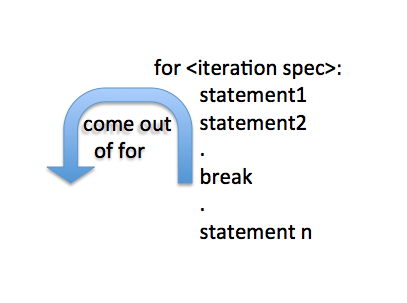Overview:
-
The break statement in Python can be provided inside a, for loop or while loop.
- break is a keyword in Python.
- Unlike other programming languages like C++ and Java, Python does not have a switch statement. So, no switch, case blocks.
- The break statement in Python makes the execution to immediately leave to the next enclosing block.
- In case break is encountered in a for/while which is inside a try block with a finally clause, the finally will be executed before the break comes into affect.

Fig: Break Statement in Python
Example:
|
#Sample Python program that generates Fibonacci numbers def genFibo(fiboCount): firstTerm = 0 secondTerm = 1 nextTerm = 0
count = 0 for i in range(0,20): if ( i <= 1 ): nextTerm = i
else: nextTerm = firstTerm + secondTerm firstTerm = secondTerm secondTerm = nextTerm
print(nextTerm) count = count+1
if count is fiboCount: print("%d numbers generated in fibonacci series..coming out of the loop"%(fiboCount)) break
fiboCount = 5 genFibo(fiboCount) |
Output:
|
0 1 1 2 3 5 numbers generated in fibonacci series..coming out of the loop |